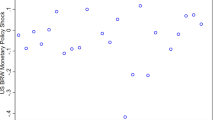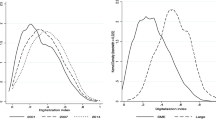Abstract
The aim of this paper is to assess whether internal devaluation is a sufficient measure to improve industrial exports competitiveness. Focusing on the cases of Greece and Portugal, two small open economies, which have recently experienced major corrective policies in the context of Memoranda of Understanding, we aim at explaining the differences observed regarding the growth of industrial exports in the two countries during the period 2000 to date. Our findings point to a number of cost items other than the unit labor cost that have increased the prices of specific categories of goods exports. Over and above that, however, the higher growth of Portuguese manufacturing exports relative to those of Greece may be explained by a variety of structural weaknesses of the Greek economy leading to its inability to retain international market shares and imposing constraints on the domestic industrial base.

Source: FRED-Federal Reserve Bank of St. Louis, EUROSTAT and EU KLEMS

Source: FRED-Federal Reserve Bank of St. Louis, EUROSTAT and EU KLEMS

Source: FRED-Federal Reserve Bank of St. Louis

Source: FRED-Federal Reserve Bank of St. Louis, EUROSTAT and EU KLEMS

Similar content being viewed by others
Notes
The actual specification in Goldstein and Khan (1985) is as follows: \(X^{d} = g\left( {Y^{*} \cdot e, P_{x} , P^{*} \cdot e} \right)\) where the first term is foreign income and the last two terms denote home and foreign prices.
An interesting dimension of the issue of competitiveness improvement relates to the corresponding export-price elasticities which can vary depending on whether the economy under consideration is an intra-union one as opposed to an extra-union one (Bayoumi et al. 2011).
According to the European Commission (2013), Greece, Cyprus, Portugal and Slovenia showed the highest borrowing rates during that period.
https://www.euro2day.gr/news/economy/article/1655057/dianeosis-ti-frenarei-tis-ellhnikes-exagoges.html , retrieved on September 15, 2019.
In addition to financing constraints and high energy and unit labor costs, according to Papanikos (2015), the nominal Euro effective exchange rate (NEER) is also responsible for the competitiveness deterioration (IMF 2017), a point that Blanchard and Giavazzi (2002) reject. This is the reason that we decided not to include REER in the price equation.
This is an index that incorporates the expectations and forecasts concerning the economic environment, as the managers of the exporting firms express these.
Using the EUKLEMS data base, for the year 2015 (the latest available) the ratio of compensation in total manufacturing to total manufacturing output for Greece and Portugal is 11% and 15% respectively.
Annual Report, Bank of Greece 2005.
References
Aslund, A. (2012). Why internal devaluation is advantageous? Real-time Economics Issues Watch, Peterson Institute for International Economics, June 6th. Retrieved from https://www.piie.com/blogs/realtime-economic-issues-watch/why-internal-devaluation-advantageous, on 19 Nov 2019.
Asmodson, I., Dorsey T., Khachatryan, I., Niculcea, I., & Sailo, M. (2011). Trade and trade finance in the 2008–09 financial crisis. International Monetary Fund Working Paper, 11/16.
Athanasoglou, P., Bakinezou, C., Georgiou, E. (2010). Export performance, competitiveness and commodity composition. Bank of Greece, Working Paper 114.
Bank of Greece (2005). Report of the Governor, Athens.
Bardaka I. (2014). Financing exports of goods: A constraint on Greek economic growth. Bank of Greece, Working Paper, No. 178.
Bayoumi, T., Harmsen, R., & Turunen, J. (2011). Euro area export performance and competitiveness. IMF Working Paper Strategy, Policy and Review Department.
Berger, H., Nitsch, V. (2010). The Euro’s effect on trade imbalances. IMF Working Paper 10/226.
Blanchard, O., Giavazzi, F. (2002). Current account deficits in the Euro Area: The end of the Feldstein–Horioka puzzle? Brookings Papers on Economic Activity, 2.
Böwer, U., Michou, V., Ungerer, C. (2014). The puzzle of the missing Greek exports. In European Commission Directorate-General for Economic and Financial Affairs.
Chen, R., Milesi-Ferretti, G. M., & Tressel, Th. (2013). External imbalances in the Euro area. Economic Policy, 28(73), 101–142.
Chor, D., & Manova, K. (2012). Off the Cliff and Back? Credit conditions and international trade during the global financial crisis. Journal of International Economics, 87, 117–133.
Clemens, D., & Schoenwald, S. (2016). No pain, no gain? Economic adjustment programmes in Greece and Portugal. KfW Research Focus on Economics, 146, 1–5.
Decressing, J., Loungani, P. (2015). The effects of wage moderation: Can internal devaluations work? IMF Blog, International Monetary Fund.
Engle, R. F., & Granger, C. W. J. (1987). Co-Integration and error correction: Representation, estimation, and testing. Econometrica, 55(2), 251–276.
Ernst & Young. (2019). Made in Greece: The Greek Export Challenge. https://www.ey.com/gr/en/issues/business-environment/ey-survey-made-in-greece-the-greek-exports-challenge. Accessed 15 Oct 2019.
European Central Bank. (2012). Competitiveness and external imbalances within the Euro area. ECB Occasional Paper Series No. 139. https://www.ecb.europa.eu/pub/pdf/scpops/ecbocp139.pdf.
European Commission. (2010). Quarterly report on the Euro area Brussels: European Union. http://ec.europa.eu/economy_finance/publications/qr_euro_area/2010/pdf/qrea2_en.pdf.
European Commission. (2013). Quarterly Report on the Euro area. In Economic and Financial Affairs, vol. 12, no. 3. https://ec.europa.eu/economy_finance/publications/qr_euro_area/2013/pdf/qrea4_en.pdf. Accessed 23 Aug 2019.
Fernandez, M. J. (2014). Spain’s internal devaluation and export growth. Spanish Economic and Financial Outlook, 3(5), 45–52.
Gazopoulou, E. (2012). A note on the effectiveness of price policy on tourist arrivals to Greece. In Bank of Greece working paper, No. 144.
Goldstein, M., & Khan, M. S. (1985). Income and price effects in foreign trade. In R. W. Jones & P. B. Kenen (Eds.), Handbook of international economics (Vol. II, pp. 1041–1105). Amsterdam: North-Holland.
Hernández, P. J. (2019). Reassessing the link between firm size and exports. Eurasian Business Review. https://doi.org/10.1007/s40821-019-00126-9.
IMF. (2015). Wage moderation in crises: policy considerations and applications to the Euro area. Staff Discussion Note 15/22.
IMF. (2016). Independent Evaluation Office: The IMF and the crises in Greece, Ireland, and Portugal.
IMF (2017). Greece: Review under the extended arrangement under the extended fund facility and request for waiver of non-observants of performance criterion and rephrasing of access: Staff report, Press release and statement by the Executive Director for Greece. Country Report.
IMF. (2019). IMF Country Report 19/73: Greece.
Jaumotte, F., & Sodsriwiboon, P. (2010). Current account imbalances in the Southern Euro area. IMF working paper 10/139.
Johansen, S. (1991). Estimation and hypothesis testing of cointegration vector in Gaussian vector autoregressive models. Econometrica, 59, 1551–1580.
Lebrun, I., & Perez, E. (2011). Real unit labour costs differentials in EMU: How big, how benign and how reversible? IMF working paper 11/109.
McDonnell, T. A., O’Farrell, R. (2015). Internal devaluation and labour market trends during Ireland’s economic crisis. NERI Working Paper Series, WP2015/No 28.
Medaiskytė, R., & Klyvienė, V. (2012). The effectiveness of internal devaluation in Lithuania and Latvia. Economica, 91(1), 59–78.
OECD. (2017a). Competition Assessment Reviews: Greece.
OECD. (2017b). Greece at a Glance: Policies for a Sustainable Recovery.
Pain, N., Mourougane, A., Sédillot, F., Le Fouler, L. (2005). The new OECD International Trade Model. Economics Department Working Papers No. 440, OECD, ECO/WKP(2005)27.
Papanikos, G. (2015). The real exchange rate of Euro and Greek economic growth. The Journal of Economic Asymmetries, 12, 100–109.
Park, J. Y. (1990). Testing for unit roots and cointegration by variable addition. Advances in Econometrics, 8, 1077–133.
Pedroso, P. (2014). Portugal and the global crisis: The impact of austerity on the economy. The social model and the performance of the state. Bonn: Friedrich Ebert Stiftung.
Peeters, M., den Reijer, A. (2012). Apart from the fiscal compact—on competitiveness, nominal wages and labour productivity. VOX, January 3rd.
Pelagidis, T. (2014). Why internal devaluation is not leading to export-led growth in Greece, Brookings. https://www.brookings.edu/blog/up-front/2014/09/12/why-internal-devaluation-is-not-leading-to-export-led-growth-in-greece/.
Pelagidis, T., & Mitsopoulos, M. (2014). Greece: From exit to recovery? Chapter 3. Washington DC: Brookings Institution Press.
Pesaran, M. H., Shin, Y., & Smith, R. J. (2001). Bounds testing approaches to the analysis of level relationships. Journal of Applied Econometrics, 16(3), 289–326.
Phillips, P., & Ouliaris, S. (1990). Asymptotic properties of residual based tests for cointegration. Econometrica, 58(1), 165–93.
Rehman, N. (2017). Self-selection and learning-by-exporting hypotheses: Micro-level evidence. Eurasian Economic Review, 7(1), 133–160.
Santos, B. A., & Fernandes, S. (2016). Internal devaluation and unemployment: The case of Portugal. In Martin Myant, Sotiria Theodoropoulou, & Agnieszka Piasna (Eds.), Unemployment, internal devaluation and labour market deregulation in Europe. Brussels: ETUI.
Tressel, T., Wang, S., Shik Kang, J., Shambaugh, J. (2014). Adjustment in Euro area deficit countries: Progress, challenges, and policies. IMF Staff Discussion Note, IMF.
World Bank. (2019). Doing Business 2019.
Author information
Authors and Affiliations
Corresponding author
Ethics declarations
Conflict of interest
On behalf of all authors, the corresponding author states that there is no conflict of interest.
Additional information
Publisher's Note
Springer Nature remains neutral with regard to jurisdictional claims in published maps and institutional affiliations.
Rights and permissions
About this article
Cite this article
Doulos, D., Katsaitis, O. & Zombanakis, G. Is the emphasis on unit labor costs an effective export-promoting policy? A comparison between Greece and Portugal. Eurasian Econ Rev 10, 393–410 (2020). https://doi.org/10.1007/s40822-020-00145-2
Received:
Revised:
Accepted:
Published:
Issue Date:
DOI: https://doi.org/10.1007/s40822-020-00145-2




